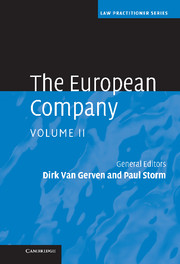11 - Portugal
from Part II - Application in each Member State
Published online by Cambridge University Press: 06 July 2010
Summary
Introduction
The European company or Societas Europaea (‘SE’) is a new corporate form introduced into Community law through Council Regulation No 2157/2001 of 8 October 2001 on the Statute for a European company (the ‘Regulation’). The Regulation has direct effect in all Member States and officially entered into force on 8 October 2001. However, the Regulation expressly provides that SEs shall be governed not only by its provisions but also by the national laws of the Member States in many areas (both specific legislation adopted for the purpose of allowing the formation of SEs as well as general legislation applicable to national public limited-liability companies) and by the provisions of their memorandum and articles of association.
Portugal has adopted a specific law, Law No 2/2005 of 4 January 2005 (the ‘SE Act’), implementing the Regulation and enacting specific provisions where the Regulation gave the Member States an option to apply or adopt their own national rules.
The general rules applicable to national public limited-liability companies (the sociedade anónima or SA) are mainly contained in the Portuguese Company Code (the ‘Company Code’), which apply to SEs with their registered office in Portugal unless the Regulation and the SE Act provide otherwise.
With respect to employee involvement in an SE, Portugal has implemented Council Directive 2001/86/EC of 8 October 2001 (the ‘Directive’) through Decree-Law No 215/2005 of 13 December 2005.
- Type
- Chapter
- Information
- The European Company , pp. 289 - 314Publisher: Cambridge University PressPrint publication year: 2008

